누룽지 튀김 [nooroongji twikim]
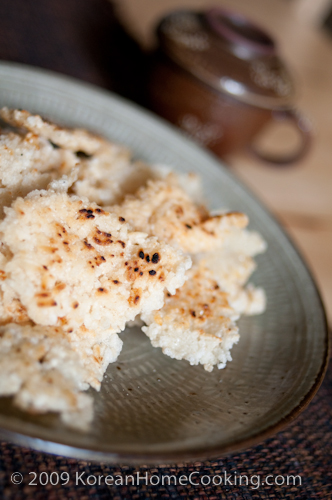
We are often mistaken to believe that the best dishes are made from a sophisticated recipe. Behind the curtains though, we all have to agree that the tastiest foods are the simpliest foods after all. Deep-fried nooroongji meets that category. Nooroongji is a slightly burned rice which could be easily made from overcooking your rice, or by roasting a thin layer of cooked rice on a griddle. This is a good way to utilize those left-over rice. Deep-fried nooroongji with sprinkles of sugar makes a wonderful rice snack for the young and adults.
Ingredients
cooked rice
sugar
1.
 Got left-over rice?
Got left-over rice?
2.
 On a griddle, spread a thin layer of cooked rice over low to medium heat.
On a griddle, spread a thin layer of cooked rice over low to medium heat.
3.
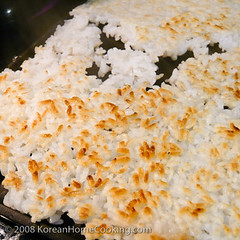 Roast them on both sides until they turn crispy and golden brown in color.
Roast them on both sides until they turn crispy and golden brown in color.
4.
 You can stop here and eat this right away as rice snack. Or, keep reading below to make deep-fried nooroongji.
You can stop here and eat this right away as rice snack. Or, keep reading below to make deep-fried nooroongji.
5.
 Deep fry the nooroongji from Step 4.
Deep fry the nooroongji from Step 4.
6.
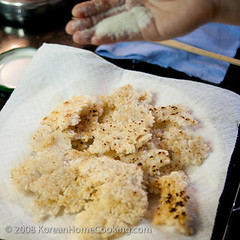 Sprinkle with sugar.
Sprinkle with sugar.
 A reader asked, and I thought about what really makes authentic Korean tea. There are teas that we drink on special occasions. On the other hand, there are couple of "common" teas that Koreans drink on a daily bais in place of regular tap or filtered water.
A reader asked, and I thought about what really makes authentic Korean tea. There are teas that we drink on special occasions. On the other hand, there are couple of "common" teas that Koreans drink on a daily bais in place of regular tap or filtered water.
If I am asked what makes Korean tea, it would be the common teas, such as roasted barley tea or roasted corn tea. We drink them on a daily basis without even realizing it's a tea. This is equivalent of Jasmine tea in Chinese restaurant or green tea in Japanese restaurant, I guess.
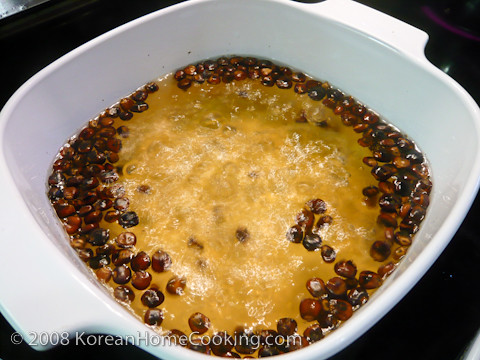
Roasted corn tea or roasted barley tea is very easy to make. Simply add roasted corn or roasted barley to boiling water and brew them for a few minutes until the water turns light gold in color, and strain and discard boiled corn or barley afterward. They are also available in tea bags.
Besides roasted corn tea or roasted barley tea, there are other more traditional Korean teas. Many of them are fruit-based or leaf-based (e.g., dried jujube tea, citron tea, persimon leaf tea, ginger tea, etc), and each of them has very unique aroma and taste.
I would like to add that green tea, especially with roasted brown rice, is becoming another popular common tea in Korea with its acclaimed health benefits. The province of Bosung in Korea is supposed to be a huge tourist attraction these days for its breathtaking view of vast green tea fields. We are looking forward to checking it out when we visit Korea next time.
서울곰탕

 Seoul Gom Tang
Seoul Gom Tang
Telegraph Ave.
Oakland, CA
Min and I were out all day shopping on a rainy day (few weeks ago), and I was being cranky from being hungry and tired. I really didn't feel like cooking at the end of a tiring day. So, we decided to eat out. On rainy days, there's nothing that makes you warmer than hot steamy soups. Seoul Gom-Tang in Oakland specializes in hot-pot Korean soups. Min's favorite from Seoul Gom Tang is bugaguk, dry pollack soup. I ordered sulungtang, beef soup. It was perfect for the weather.
두부스테이크
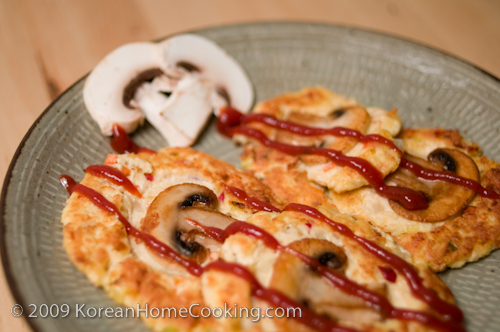 We had this tofu patty as a side-dish along with our rice meal. Other than being a side-dish, I think this dish alone could make a wonderful vegetarian alternative to a beef patty. The key here is to drain out water from tofu completely. If you have a piece of cooking linen, try using it to squeeze out water from tofu.
For 4 servings
oil for the pan
We had this tofu patty as a side-dish along with our rice meal. Other than being a side-dish, I think this dish alone could make a wonderful vegetarian alternative to a beef patty. The key here is to drain out water from tofu completely. If you have a piece of cooking linen, try using it to squeeze out water from tofu.
For 4 servings
oil for the pan
tofu (1 pack, medium firm)
carrot (1/4, chopped)
onion (1/2, chopped)
zucchini (1/4, chopped)
mushroom (3, sliced)
Korean pancake mix/부침가루 (3 tbl, or flour)
potato starch/녹말가루 (3 tbl)
salt and pepper
1.
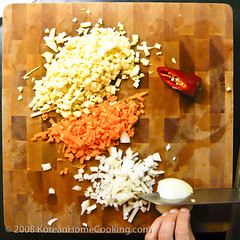 Chop carrots, zucchini onions, and set aside.
Chop carrots, zucchini onions, and set aside.
2.
 Slice mushrooms.
Slice mushrooms.
3.
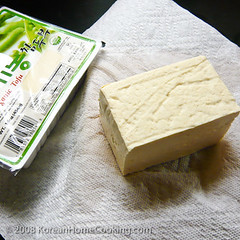 Pat dry tofu and drain water completely. Or, squeeze out water completely by tightly wrapping in a cooking linen, if available.
Pat dry tofu and drain water completely. Or, squeeze out water completely by tightly wrapping in a cooking linen, if available.
4.
 In a large bowl, mix the chopped vegetables from Step 1 (except mushroom), and add pancake mix (3 tbl), potato starch (3 tbl), egg (1) and a dash of salt and pepper. Be sure to add enough salt.
In a large bowl, mix the chopped vegetables from Step 1 (except mushroom), and add pancake mix (3 tbl), potato starch (3 tbl), egg (1) and a dash of salt and pepper. Be sure to add enough salt.
5.
 Crush the tofu from Step 3.
Crush the tofu from Step 3.
6.
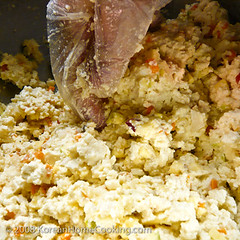 Mix them well together.
Mix them well together.
7.
 Oil the pan over medium to high heat.
Oil the pan over medium to high heat.
8.
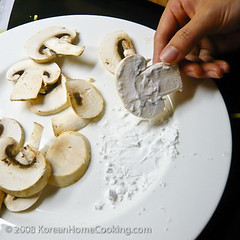 Coat each mushroom slice with potato starch.
Coat each mushroom slice with potato starch.
9.
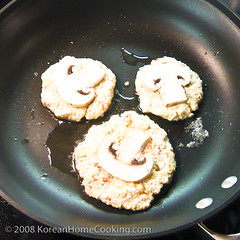 Pan fry the vegetable-tofu patty over medium heat and top it with a slice of mushroom from Step 8. Serve with ketchup or steak sauce.
Pan fry the vegetable-tofu patty over medium heat and top it with a slice of mushroom from Step 8. Serve with ketchup or steak sauce.
 Oyster Salad
Oyster Salad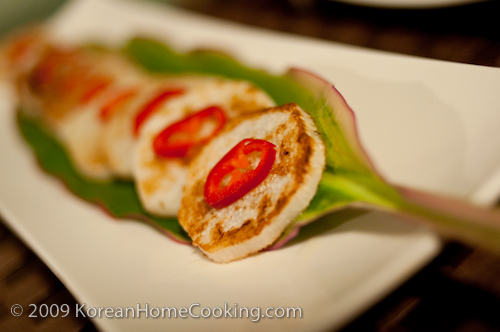 Majeon
Majeon 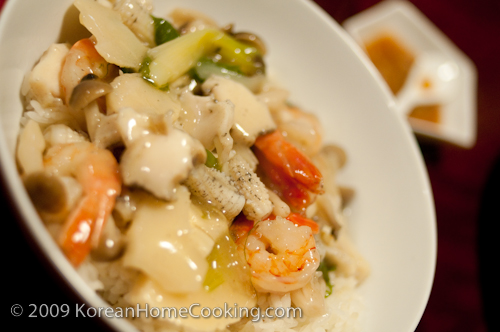 Seafood over Rice
Seafood over Rice Beef Wrap
Beef Wrap Tofu Vegetable Patty
Tofu Vegetable Patty Vegetable Trio
Vegetable Trio




















